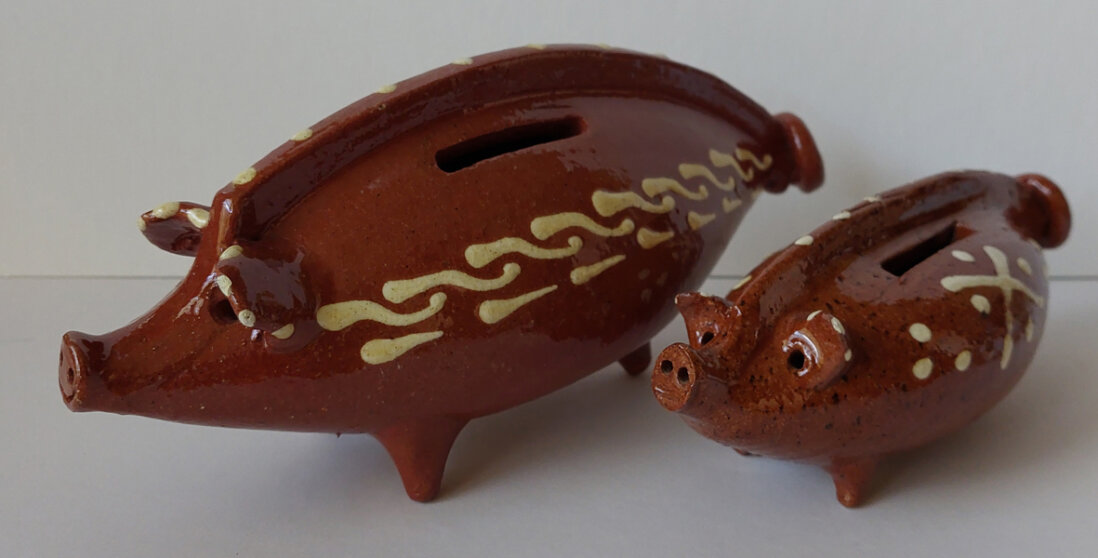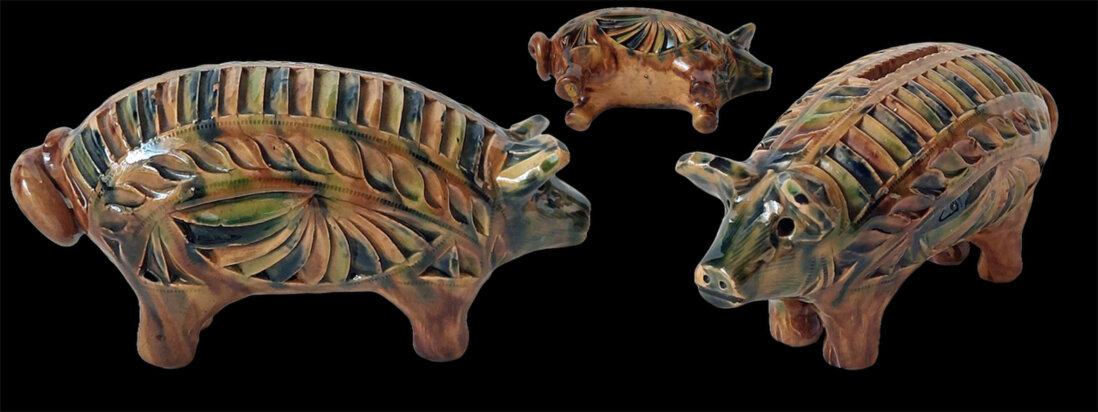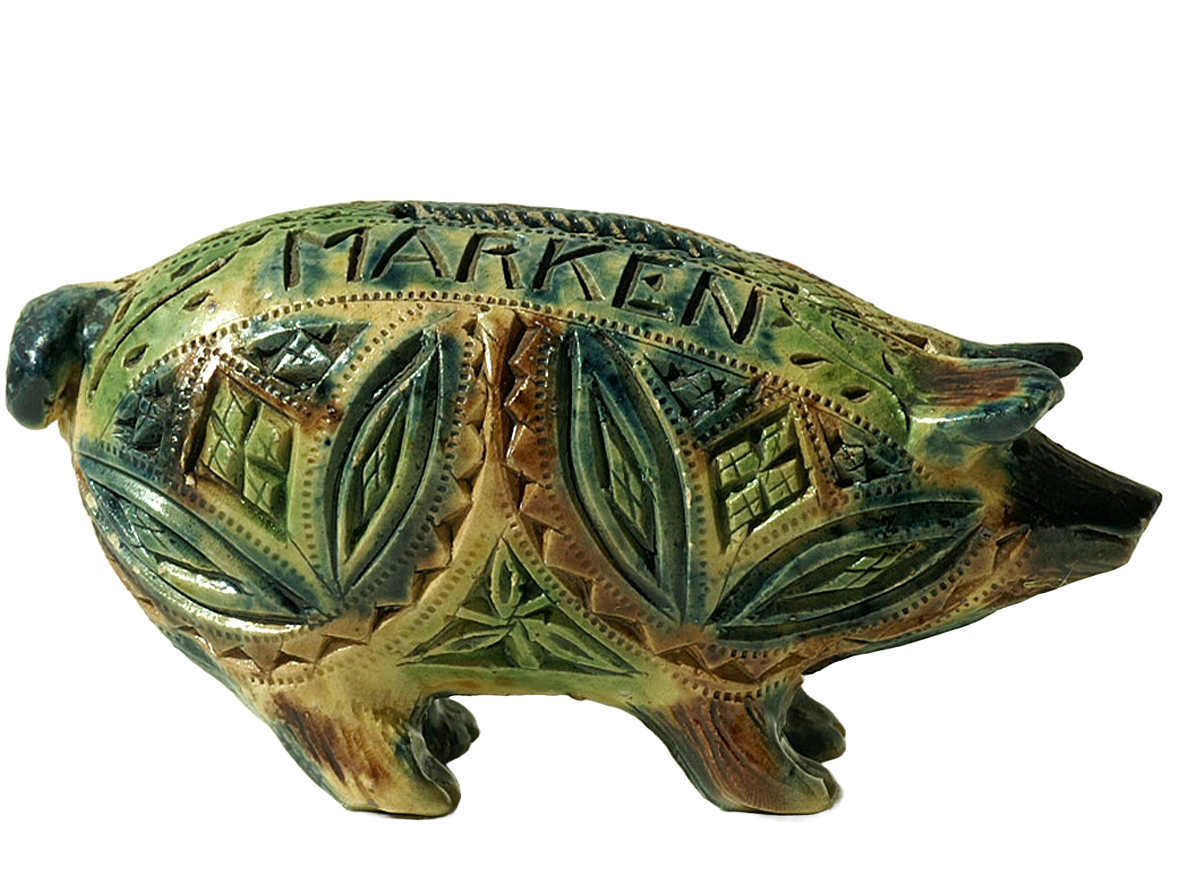Famous brands
Collection 1 > The Netherlands

Friesland/ Fryslân
- Makkum: From 1572 until september 2013 Royal Tichelaar Makkum concentrated on ornamental earthenware. Tichelaar Makkum used the age old majolica technique, in which local Frisian clay is covered with white tin glazing on which the decorations are painted, glazed again and fired on lower temperature. In my collection there are 4 Royal Tichelaar piggy banks. Nowadays only available in the webshop (see 'traditional') .
- Workum had a flourishing earthenware industry for over 300 years. Only one or two potters still produce. The last existing factory of De Boer was dismantled in 2007 when Rintje de Boer died. He was the last person of the family that kept the tradition of green lead glazed piggy banks alive.
- Harlingen/ Lemmer: Once an well-known places for earthenware.
Makkum
“WHAT THE HELL ARE YOU DOING?”

Porcelain money box in the shape of three piggy banks, design Jurgen Bey ca. 2000, made in limited edition by Royal Tichelaar / Makkum.
Stamped: Makkum brand & JR Bey. Height 16 cm, width 18.5 cm, depth 6 cm.
On the right, individual white piggy bank also by Royal Tichelaar/Makkum. Both in my collection.
Stamped: Makkum brand & JR Bey. Height 16 cm, width 18.5 cm, depth 6 cm.
On the right, individual white piggy bank also by Royal Tichelaar/Makkum. Both in my collection.
WORKUM and surrounding areas
As in many places along the former Zuiderzee, characteristic utilitarian pottery can be found in Workum. The original Workumer pottery is simple brown with decorations in the ring ear technique. That is pottery decoration with white engobe or liquid clay sludge. The light-coloured clay is applied to the brown surface using a “ringeloor” (an earthenware spout or a cow horn with the tip ground away). After this, the whole is covered with a transparent lead glaze. The decoration is simple and consists mainly of lines and dots. Often multicolored. The technique of pottery painted with engobes is called “ringeloor pottery” in Frisian, “slip-decorated pottery” or “slipware pottery” in Dutch, “terre-vernisee” in French and the English name is “slipware-ceramics”. piggy banks have three legs and a typical knotted tail. There are of course (typically Dutch?) exceptions to the 'rule'.

My largest brown “Workum type" earthenware piggy bank with slip decoration, 24 cm length and a smaller one of 18.5 cm. By the way, “Workum pottery” has become a generic name and does not have to be made in Workum.
The fish shape? Originally they were folded from a round slab of clay. The diameter determined the length of the piggy bank. Fold the ends together, pinch the edge firmly (this creates the rib) and you almost have a piggy bank. Shape the head, put ears and 3 legs underneath, cut a coin slot in it. The hardest part is making the knot tail. This is possible with small quantities. In mass production, if there ever was one, a mould was used.
Frisian carving
The notched technique (carving or in Dutch "kerfsnee") is one of the oldest decoration techniques and is known in many cultures. Our distant ancestors carved not only wood, but also stone, pottery, bone and mammoth ivory. The carving of Runic signs is already described in the Icelandic EDDA. In addition to rune signs, rune stones from Northern Europe also depict rosettes that are still used today for making Frisian carvings or carvings. The notched ('kerfsnee") piggy banks have 4 legs.

ANTIQUE, 1905. Pottery factory De Boer – Workum. Carving by Jacob Meines Visser (1864-1954). Transcription translated: "De Zusjes (sisters), December 20, 1904; MaakMijVet (Make Me Fat)"

You rarely come across a Frisian carved piggy bank in these colors. I bought it from a collector with specialty “Lemmer”. He determined that this certainly did not come from Lemmer: “much too coarse”. Where from then? I have only seen this color scheme at “Velzer aardewerk” (1920-2002, last name Velzen Keramiekfabriek in Sassenheim). But does it come from there? Length 15 cm.
More Frisian pig piggy banks
Green Frisian pottery (with the poisonous - and long prohibited for 'household' - opaque lead glaze) is also known, but not typically Workum. And of course carved earthenware, which was made not only in Workum but also in Lemmer and furthermore in Sneek.

Gouda
Gouda: Most potteries which existed until the '60's were integrated in bigger firms or just vanished. The Gouda piggy bank had 4 legs, cross stripes on the body and a tail as a knot. It is green led glazed. Led glaze appears to be poisonous, so a EC regulation (± 1989) decided that this kind of glaze was forbidden. And a whole industry of ceramic household ware became extinct. Many Gouda piggy banks have a number that corresponds to a certain length. Unfortunately, there was no uniform system, all producers had their own numbers and sizes.
Antique Gouda piggy bank from ± 1850. Probably an excavation find, bought in 1989 at a boot sale in Krimpen aan de Lek. Length 13.5 cm. Contrary to the "rule", not green with 4 legs, but yellow with 3 legs. And inevitably battered. Collection number 135.

Delft
Delft is a type of faience with blue decoration, traditionally manufactured in Delft. Other types of Delftware are multicoloured or white. The industry was wiped out round 1800 by cheaper pottery, especially from England (Staffordshire). Today there are only two factories left where 'real original' Delftware is produced: Royal Delft Pottery “De Porceleyne Fles” and Heinen Delfts Blauw (in Putten-Gld, which took over the 'Delftse Pauw' in 2018; the factory/ pottery 'Delftse Pauw' no longer exists since September 2021). In addition to Delft Blue pottery, there are multicolored Boerendelfts and Delft white.Delft Pottery “De Delftse Pauw”) . Most of the Delftware sold today (even in Delft!) is Chinese or (if you are lucky) excellent Dutch imitations.









































































